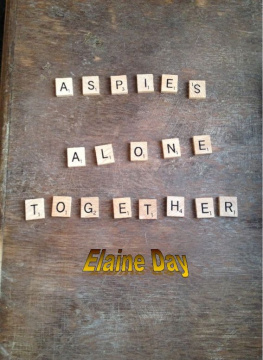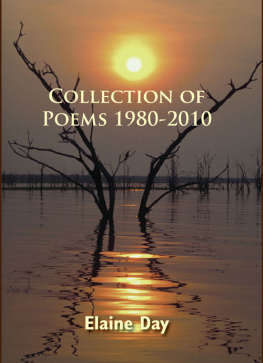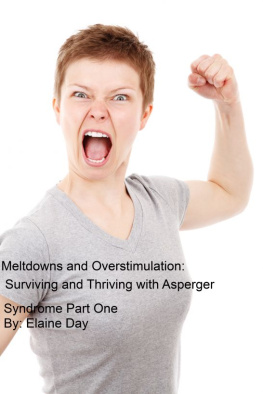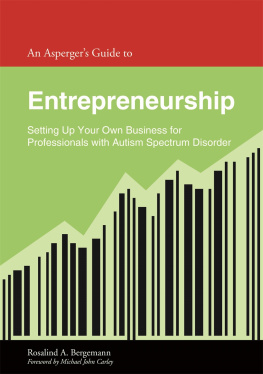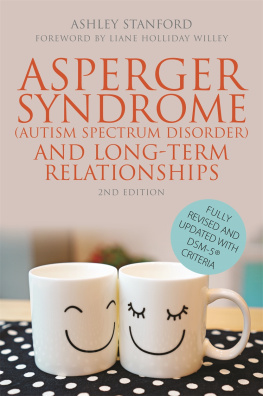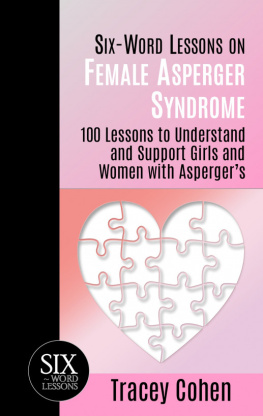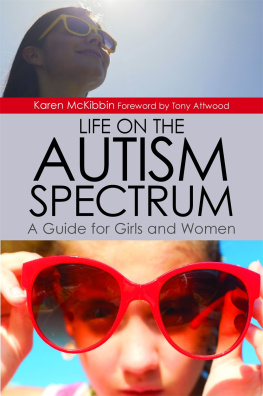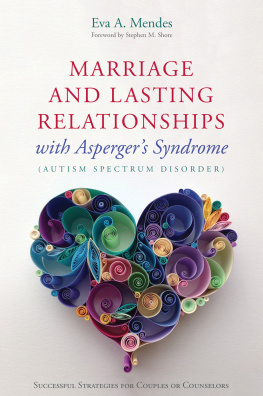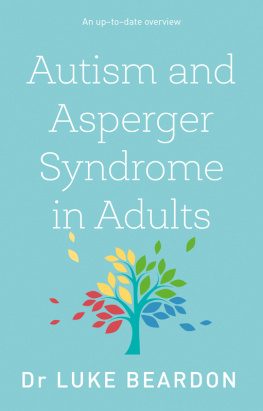Aspies Alone Together: My Story and aSurvival Guide for Women on the Spectrum
By Elaine Day
Smashwords Edition
Copyright 2014
About the Author
While this section often comes at the end ofa book or is found on the back cover, I find that it is relevant tothe writing of this book for the reader to know who I am. At thetime of this writing, I am a 33 year old Aspie who has only beendiagnosed for a little over a year, though I have known for a bitlonger.
My family history is a bit convoluted, andexplaining it will help many parts of this book make sense. I wasadopted shortly after I was born, but my adopted mom left and myadopted dad passed away when I was a year old, although I wasalready living with his parents when he passed. My grandma andgrandpa were the parents I knew all my life, and they loved meunconditionally, even though a condition that, particularly becausewe knew nothing about it, made me incredibly difficult to deal withat times. My Grandma passed of kidney failure when I was 11, afteryears of sickness, and my Grandpa raised me until I was 16. The momI talk about throughout this book is my biological mom, with whom Ireconnected at the age of 20.
I grew up in much the same way as my peers. Iwas taught how to make friends and how to engage socially, andbecause of that that I was blessed with friends and the ability tofit in better than many males on the spectrum might without adiagnosis. I may have always stuck out like a sore thumb in somesituations, but I had the social skills needed to survive, even ifthey didn't come naturally. Part of this is simply because I am afemale, and part of it comes from growing up in the American South,where please, thank you, yes ma'am, and eye contact are drilledinto your head the way a teacher might do with a specific mathrule. My grandparents worked hard to instill me with manners andsocial skills, and I am eternally thankful for that.
With that said, life with undiagnosed AS wasoften hard. I often said or did the wrong thing (still do), andfrequently I realized that I just didn't feel normal or much likemy peers. I dabbled in the theory that I was an alien, wondered ifbeing adopted meant that I just couldn't feel normal, or whetherthere was something inherently wrong with me. Like my AS hero JohnElder Robison, there was even a time when I was desperately worriedthat the way I felt (and didn't feel) meant that I was a secretsociopath, destined to one day end up in prison.
Not fitting in didn't just mean not gettingthe cool table at lunch. It meant doing something against the rulesin physical education one day and being treated to a large group ofclassmates singing "Blame It On Elaine" to the tune of a popularsong at the time. It meant getting bullied my entire life. Toldthat my mom gave me away because I was stupid during ballet class,beaten up on the bus almost every day, and most importantly, thevictim of sexual bullying at the hands of older kids and eventuallyadults. It's a dangerous side of being an Aspie, the increasedlikelihood of bullying and sexual abuse, and it is one that will beaddressed in this book.
With that said, I feel that I have grown upinto a functional and successful adult. I still need a therapistand psychiatrist to help me manage the symptoms of AS, but I amsuccessful nonetheless. I have a strong, if small, circle offriends who understand me completely. I have a career that lets mebe my own boss and that lets me take breaks when I need them,whether for an hour or six months. But most of all, I have afamily. A beautiful wife (thank you Vermont for making that legal),two beautiful children, and a menagerie of pets who all constantlyremind me that being wired differently isn't a deficit or aproblem, but instead quite often a beautiful gift indeed.
Introduction
My ah-ha moment came in the middle of thenight. I had gone to the bookstore and picked up a copy of a bookcalled Look Me In The Eye by John Elder Robison. I had never heardof Asperger's, but the book looked funny, was on sale, and waswritten by the brother of one of my favorite authors of all-time. Istarted reading after my wife went to bed, and it wasn't long atall before I started finding myself in every word. Every page ledto another ah-ha moment, another time I would elbow my dear wifeand explain to her that I was practically reading a book aboutmyself. Needless to say, she didn't get much sleep that night.
For many these days, there is no ah-ha momentso much as a diagnosis made at the suggestion of a teacher or daycare provider or even a pediatrician. But for many adults withAsperger's Syndrome, we have been living undiagnosed for manyyears. This book is written for anyone and everyone, but primarilyit is designed as a survival guide for women with AS who haven'thad years of formal diagnosis, CBT, and help and for those of usgetting diagnosed in our 20's, 30's, 40's, 50's, and beyond.
There are hundreds of books out there forpeople on the spectrum, but the vast majority of these books areaimed at males. It makes sense, as there are many males on thespectrum, but the large number of females on the autism spectrummeans that we need resources, too. While AS is similar between thesexes, there are also many differences. For many females, we aretaught social skills, or how to mimic them very early. This methodof fitting in, even when it feels unnatural, can mask diagnosticcriteria and can mean that many females go undiagnosed until wellinto adulthood when the deficits caused by AS start to causeproblems. This can be in the workplace, in relationships, orelsewhere, but the simple fact is that for those who are wireddifferently, AS will eventually rear its head and it is criticalthat we see it for what it is and respond appropriately.
My goal with this book is multi-fold. Inpart, I want to tell my story and share with other readers how Ihave coped and how I grew up. I also want to create a sort ofsurvival guide for others like me. And at the end of the day, Iwant to provide a good read for anyone who chooses to pick up thisbook and peruse its pages.
It is my hope that it helps others find thestrength and skills that I've had to form over the years withgreater ease and that, if nothing else, it reminds all of you thatyou aren't alone. Even when isolation is the only thing you need inthe world, there is a strong bond between us all and we arecertainly Aspies alone together.
What's Really So Different for Women on theSpectrum?
It's hard to pinpoint all of the littlethings that make life as a female Aspie different. And part of thatis in the cultural difference between the sexes. Little girls aremore likely to be taught eye contact, pleases and thank yous, waysof engaging with adults and other children, and other social skillsfrom a very early age. Social deficits are not something thatcannot be overcome to some degree and that there is no diagnosticrule that Aspies can't make and be friends. With that said,however, a profound deficit in social skills and lacking peerrelationships are criterion that are currently used to make adiagnosis.
So what happens when you have an entiregender of people for whom solo play is socially frowned upon? Whathappens when "boys will be boys" isn't an option and these lackingsocial skills are gained via rote memorization of responses,actions, and behaviors? For many females, it means missing adiagnosis of Asperger Syndrome.
Another diagnostic criterion used indetermining if someone has AS is whether they respond withreciprocity in social situ ations. Again, many of today's younggirls (and yesterday's, of course) are taught pleases, thank yous,and how to react to a gift or compliment (even if they don't likeit) with gratitude or the appearance of it. Social reciprocity, eyecontact, and even mannerisms are actually physically taught to usfrom an early age in an attempt to make sure that we develop intoappropriately mannered young women, and the simple fact is that itcan make diagnosing AS at a young age almost impossible given thecurrent blanket criteria.
Next page
